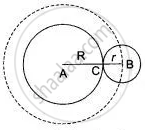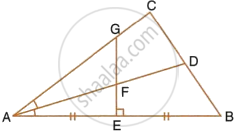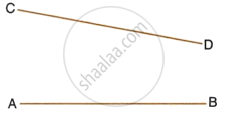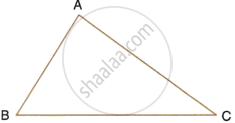Advertisements
Advertisements
Question
Find the locus of the centre of a circle of radius r touching externally a circle of radius R.
Solution
Let a circle of radius r (with centre B) touch a circle of radius R at C. Then ACB is a straight line and
AB = AC + CB = R + r
Thus, B moves such that its distance from fixed point. A remains constant and is equal to R + r.
Hence, the locus of B is a circle whose centre is A and radius equal to R + r.
APPEARS IN
RELATED QUESTIONS
Use ruler and compasses only for this question.
- Construct ΔABC, where AB = 3.5 cm, BC = 6 cm and ∠ABC = 60°.
- Construct the locus of points inside the triangle which are equidistant from BA and BC.
- Construct the locus of points inside the triangle which are equidistant from B and C.
- Mark the point P which is equidistant from AB, BC and also equidistant from B and C. Measure and record the length of PB.
The given figure shows a triangle ABC in which AD bisects angle BAC. EG is perpendicular bisector of side AB which intersects AD at point F.
Prove that:

F is equidistant from AB and AC.
In the figure given below, find a point P on CD equidistant from points A and B.

In the given triangle ABC, find a point P equidistant from AB and AC; and also equidistant from B and C.

Describe the locus of the door handle, as the door opens.
Describe the locus of points at distances greater than or equal to 35 mm from a given point.
Prove that the common chord of two intersecting circles is bisected at right angles by the line of centres.
Find the locus of points which are equidistant from three non-collinear points.
Given: ∠BAC, a line intersects the arms of ∠BAC in P and Q. How will you locate a point on line segment PQ, which is equidistant from AB and AC? Does such a point always exist?
The bisectors of ∠B and ∠C of a quadrilateral ABCD intersect in P. Show that P is equidistant from the opposite sides AB and CD.
